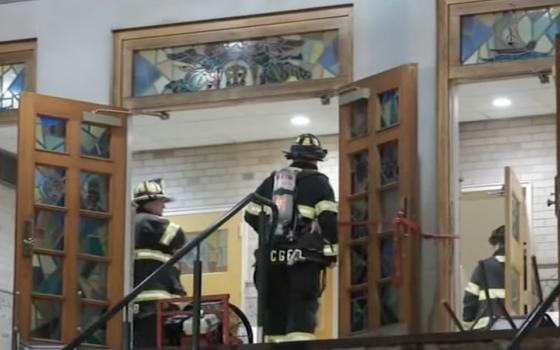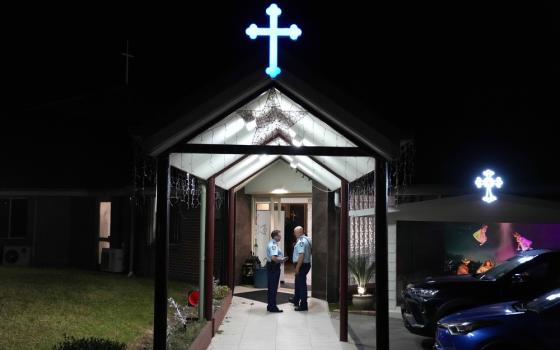
PALENQUE, MEXICO -- Ask Srs. Leticia Pérez or Micaela Méndez about the most difficult part of their religious formation, and they answer without hesitation: the language. Not Hebrew or Greek, but Spanish -- the lingua franca of Mexico, but a second language for Méndez, 32, who is Cho’l, and Pérez, 31, who mother tongue is Tzeltal.
Like most women in the Mayan villages scattered throughout the forests and hills of Chiapas in southern Mexico, Spanish is a second language for both of them. And it was just one of the things that made joining the Sisters of St. Francis of Penance and Christian Charity in Palenque, a town best known for its ancient Mayan pyramids, something akin to entering another world.
“It was strange at first,” Pérez said. “Being unsure about Spanish, it’s hard to express yourself and relate to other people.”
No vestiges of that insecurity remain as Pérez leads the scripture reflection during the Sunday liturgy in the chapel beside the sisters’ house or as Méndez describes the indigenous theology movement in which she is active. But Nely Torres, 22, who arrived in May, is more hesitant, responding to questions in her native Cho’l as Méndez interprets.
Méndez, Pérez and Torres are the first generation of indigenous sisters in this missionary congregation that has put down roots in Palenque -- the Mayan face of the local church that the late Bishop Samuel Ruiz envisioned for Chiapas.
Throughout Latin America, religious congregations once drew vocations from well-educated, middle- or upper-class families. But when they embraced the option for the poor in the 1970s and moved into rural and peripheral urban areas, they began attracting young women from those places, where families are more likely to be poor or indigenous.
That is only one of the changes with which formation directors must grapple in a region where rapid urbanization and globalization are changing the church, its ministries and its ministers.
“We all see the challenges,” said Maryknoll Sr. Linda Donovan, who coordinates a nine-month program for formation directors in Santiago, Chile. “The formation directors who come today [must ask] not only, ‘Who am I going to be forming?’ but ‘For what?’ ”
That program, which Chile’s Conference of Religious has offered since 1989, has seen participation decline in recent years.
“There was a time when this course had 25 to 30 people every year,” Donovan said. Last year, there were 17, and this year there are eight. As fewer people enter and religious communities become increasingly international, “formation in the communities has been internationalized,” she said.
The Franciscan sisters in Palenque are an exception. When they first arrived from California in the early 1990s, they did not even intend to take vocations. “When the first young woman approached us, we didn’t know what to do,” said Sr. María Elena Rodríguez, one of the mission’s founders.
Ruiz urged them to provide formation in Palenque instead of sending postulants or novices to study in Mexico City or another country, as other communities did.
“He said that when you take the person away from here, you uproot them from their culture and their family, and that can affect them in the future,” said Sr. Consuelo Arana, who coordinates the formation program in Palenque.
Congregations that send young women to Mexico City for formation have found that it is difficult for the young women to leave Chiapas, and even harder for them to return home, she said. The cultural divide between the rural, indigenous world and urban life is too wide.
So the sisters opened the doors of their simple house in Palenque to young women who were attracted by their work with women, children and deacons in the remote villages. Despite the difficulties the young women faced -- learning to express themselves in Spanish, navigate the city and drive a car -- they also found affirmation of their identity in a society that discriminates against indigenous people, especially women.
“I’m grateful to the congregation, because it has given me the opportunity to be proud of being Cho’l,” Méndez said.
“That’s something no one can ever take away from us,” Pérez added. “It’s a great thing.”
Multicultural formation requires patience and acceptance on all sides, said Sr. Consuelo Arana, who accompanies the young women. “We take into account the cultural aspect, the situation from which each person comes. We take each person as she is,” she said.
In Mayan culture, that means welcoming the young woman’s family and community as well. Relatives can come to visit -- or even stay with the sisters for a time -- although the second floor of the house is private space for the sisters. Because the sisters consider it important for the young women to nurture the bond with their communities, they return home for two weeks a year and for special occasions, such as birthdays or Mother’s Day.
“When they go through difficult moments, it’s the community that supports them,” Arana said.
In other parts of Latin America, however, those support networks are becoming attenuated, according to Carmelite Sr. Sandra Henríquez, a member of the coordinating team of the Conference of Religious’ Studies Center in Santiago, where young men and women in formation study.
In an age of individualism, “this generation doesn’t come with a family” that provides guidance about life decisions, she said.
That contrasts with the experience in Chiapas, where the Franciscan sisters consult with both the young woman’s family and her community during her formation, because her vocation “comes from the community and is for the community,” Rodríguez said.
Changes within religious communities pose additional challenges for formation directors, who are sometimes grappling with their own identity and that of their congregation, Donovan said.
Topics covered during the program for formation directors in Santiago range from psychology and journaling to listening skills, spirituality, the Latin American church, leadership, sexuality and belonging to a community. A 30-day Ignatian retreat, divided into three parts, gives the directors time to assimilate what they have learned.
The course is long and intensive, but Donovan said it pays off.
“If congregations invest in their people, in formation and in actively going after vocations, they tend to have them,” she said.
In fact, cultivation of vocations begins in the village, in the neighborhood, wherever sisters work, said Daughter of the Holy Spirit Sr. Rosa María Moreno, assistant secretary general of the Latin American and Caribbean Confederation of Religious, based on Bogotá, Colombia.
Vocation promotion “isn’t fishing,” she said, but depends on grass-roots work that includes “strategies for human formation.”
That is as true for the Mercy Sisters in Condevilla, a noisy, traffic-clogged neighborhood on the north side of Lima, Peru, as it is for the Franciscans who work in rural Mayan villages in Chiapas.
Missionary Mercy Sisters have lived in Condevilla since the 1980s, when the area was a sandy plain where families marked off small lots and threw up one-room shacks made of straw mats. Over the years, they have watched as shacks have morphed into colorfully painted brick houses; electricity, water and telephone lines arrived; and streets were paved.
Mercy Sr. Patricia Mulderick recalls some of the momentous decisions about how to maintain a simple lifestyle -- should they buy a television? Install a hot-water heater?
In those days, most of the sisters were foreign missionaries; there were just a few young Peruvian women considering religious life. Now the tide has turned, with three foreigners and 11 Peruvian women. Sr. Nidia Huanacuni, 35, an Aymara woman from Ilave, in the southern highlands, took her final vows in June, becoming the newest full member of the community.
Most gratifying, Mulderick said, is that some of the first Peruvian women to join the community are now in leadership positions.
The formation process is long, giving the women plenty of time for discernment. “The real question is not ‘Why did you come?’ but ‘Why do you stay?’ ” Mulderick said.
Sr. Rosalí Vargas, 27, of Cajamarca in northern Peru was drawn to the charism of service in the congregation, where life revolves around prayer, community and service, especially to the poor, the sick and those without education.
The first Peruvian women were very young when they approached the community; many were motivated by their experience in parish youth or renewal groups. Later, the congregation drew women in their 30s who already had careers, but were seeking something more.
For Sr. Blanca Quintana, 47, a psychologist, the initial motivation was not a desire for religious life, but her quest for God. Her search “for a place where I could serve and feel comfortable” eventually led her to the Mercy house.
With women from various parts of Peru, both urban and rural, members of the community have learned to adjust to different customs, cultural styles -- and food. They have also had to break through traditional concepts of authority, in which foreigners are seen as having the last word, said Sr. Mary Anto Pasache, 38, of Chulucanas in northern Peru.
One cultural pattern the missionary sisters have had to overcome is a hesitancy to explicitly promote religious life, Mulderick said. What Americans see as giving a woman space to make her own decision is sometimes interpreted as a lack of interest in the woman’s vocation, she said. Being reminded of that led the sisters to be more forthright.
“If we’re happy and we think our lifestyle is worthwhile for others, why not invite people to that?” she said. It worked with Pasache, who recalls Mulderick telling her that there was a bed waiting for her at the sisters’ house whenever she was ready.
“Often,” Mulderick said, “that’s all we need to do -- to invite young women and tell them, ‘Come, there is something here for you.’ ”




